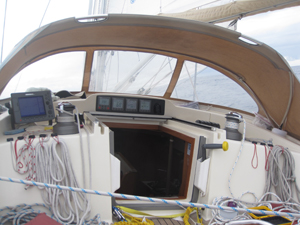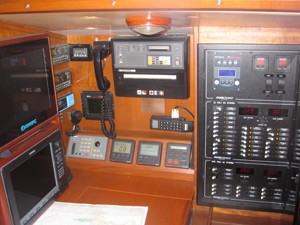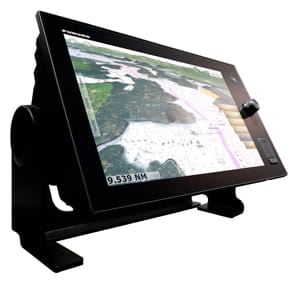Ocean and coastal sailors alike frequently find ourselves “on watch” short-handed or alone. We’re routinely forced to manage the vessel underway during periods of low-visibility, high traffic, etc. — situations that strain the attention of even the most experienced sailors. The more aware of our surroundings we are, the quicker we can make prudent decisions.
One of the greatest enhancements in marine electronics in recent years which greatly facilitates our ability to calmly master our vessel in motion is the multifunction display (MFD). Sailors can now interact with one primary display screen to access and control nearly all the marine electronics we’d like to have aboard our vessels.
 |
 |
|
Paul Exner Modern bright MFD units are not relegated to the nav station, but can be installed in the cockpit under the dodger or on a steering pedestal. |
Ultimately it’s our instinctual grasp of all info beaming at us that we act upon (naturally perceived and electronically derived data). Every sailor wishes to pay attention to different blends of info at different times. Recently, marine electronics manufacturers have been able to provide electronic information via a single MFD unit that’s customizable enough to suit any sailor’s inclination for the info that most interests them.
MFDs can typically display a wide array of information from marine electronics. The following general categories of marine electronics can be integrated into the MFD:
Navigation: GPS chartplotter; radar/AIS; fish finder; digital depth.
Boat specific instrumentation: speed; engine; house electrical bus; cameras.
Environmental instrumentation: apparent-wind; true wind; weather; sea surface temp.
Guidance: autopilot; fluxgate compass.
MFD technology provides us the following practical advantages: 1) Watchkeeping crews can view and easily organize the electronic info needed to manage the vessel in its immediate surroundings, unconstrained by the limited functionality of older electronics; 2) short learning curve and easier customization with MFDs; 3) technological advancements in display-screens, waterproofing, touch-screen, wireless and networked communication, and remote control, enhances the MFD system so it can be used anywhere on the vessel (behind the dodger, at the helm station, or down below at the navigation station).
The greatest advantage of the MFD is that nearly all categories of marine electronics can be interfaced with it, and then organized into useful screens easily and flexibly so multiple users can interact with the system to their liking. This gives watchkeepers a more involved and better chance of successfully keeping the vessel on track during their watch. For example, if the 2000 to 2400 watch prefers to use the MFD for chartplotting, waypoints, and autopilot set for a magnetic heading, while the 0000 to 0400 watch needs to turn on the radar for squalls, monitor the AIS for ships and hand-steer, the watch-crews won’t hesitate in customizing the MFD to suit their need at the time.
Whether we upgrade to an MFD using our existing onboard electronics, or we buy a new MFD and a new suite of sensors, it’s important to consider several points before making the investment. First, write a specification that defines what the system should do aboard your boat. The specification should begin by matching your sailing style to your anticipated electronics needs; do this before gathering a pile of marketing literature. Define the budget, because having a slick remote-controlled thermal night vision camera is great if it fits the budget and we still can get all the fundamental equipment. Cost is a function of screen size and frankly bigger is safer because we just can’t read the small screens when we most need that information (rain and rough weather; or from across the cockpit).
Detailed inventory
When considering an upgrade from existing onboard electronics to a new MFD, make a detailed inventory of what’s already on board before talking with a manufacturer representative, because this is the first thing they’re going to ask you. It’s often recommended to keep all the electronic components within the same brand platform; although, most manufacturers provide data-language translators to cross-connect dissimilar brands, a practice with a reputation for unreliable results. Ensuring network compatibility between electronic components is a critical piece to consider when adding features to an MFD, a detail best investigated on a case-by-case basis.
Ask yourself tough questions before making your final MFD selection — create a practical-use plan that gets to the heart of your sailing style and then choose the MFD based on how you like to work. For example, in deciding how much feature-power you need from an electronic system, think about challenging practical-use scenarios like this: “Is my sailing-style sophisticated enough to decide which autopilot setting to use (magnetic or apparent-wind angle), including which rudder-sensitivity setting to use? Can I balance the sails and electronic controls for the conditions, in an effort to minimize my vessel’s yawing motion while going for max boat speed and sailing an optimal course over the ground?”
If your answer to the above question is: “yes, my style is sophisticated…” then we know that your autopilot must have settings for magnetic heading and apparent-wind angle, which in turn specifies a need for a fluxgate compass and wind instruments that interface with the MFD. You’ll also need a chartplotter to help determine an optimal course over ground.
Self-investigation into the numerous MFD products on the market is a daunting but necessary educational step. At some point most sailors will need to speak with brand-specific manufacturer representatives or a marine electronics consultant who can help specify, build, and install a complete system on your boat. If you go-it-alone purchasing and installing an MFD, it’s recommended that you have an aptitude for computer networking, 12-volt and AC systems; and you’ll likely need experience cutting holes in your boat and making water-tight seals.
Finally, once you’re out at sea, standing watch, sailing the boat and interacting with an MFD, you’ll fully appreciate its full capabilities.
———
Paul Exner is the owner and chief in-structor at Modern Geographic Expeditions (ModernGeographic.com), which provides at-sea training for voyaging.

